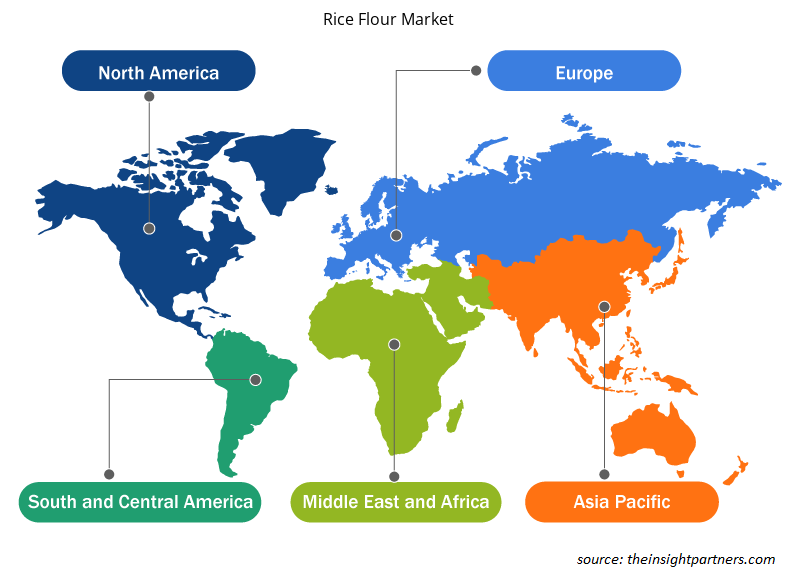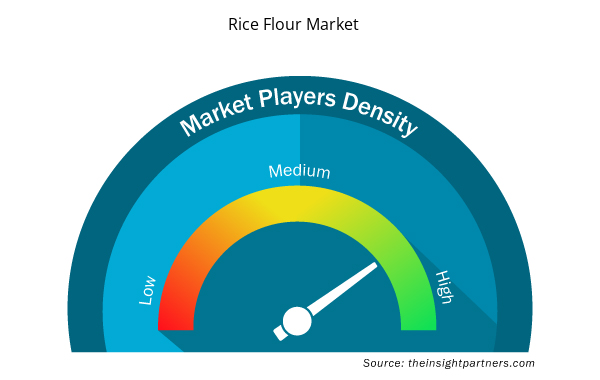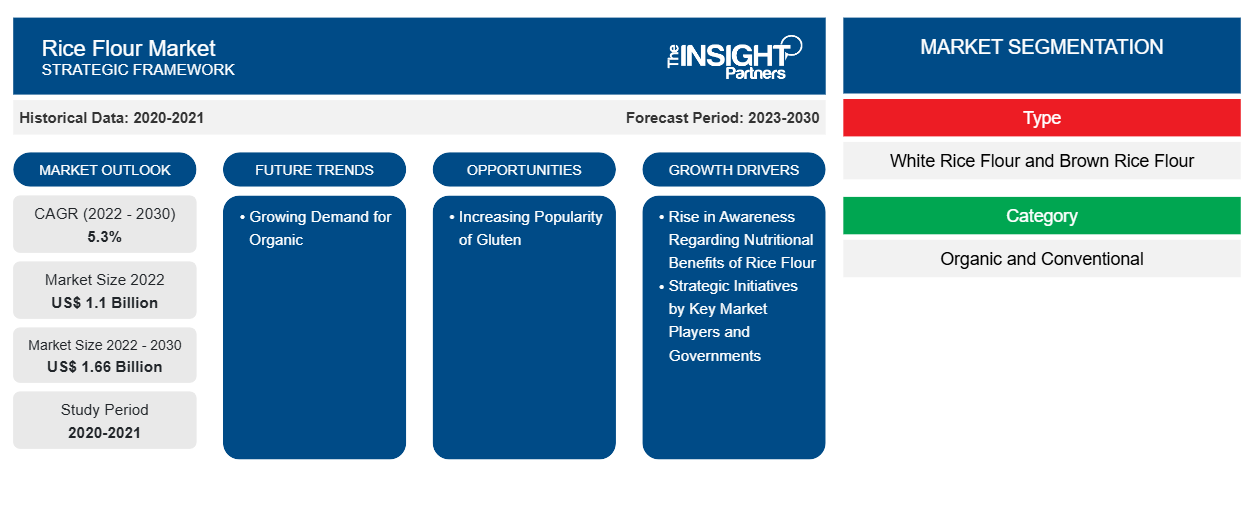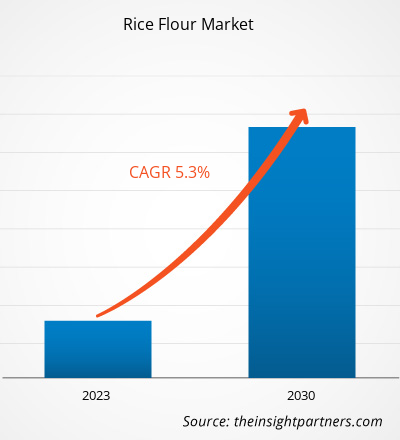[研究报告] 2022 年米粉市场规模价值 11.0047 亿美元,预计到 2030 年将达到 16.5582 亿美元;预计 2023 年至 2030 年的复合年增长率为 5.3%。
市场洞察和分析师观点:
米粉是将米粒磨成粗粉和细粉制成的。米粉不含麸质,因此被用作小麦粉的替代品。消费者对健康的日益关注和对无麸质饮食的日益增长的需求推动了米粉市场的增长。米粉具有多种健康益处,包括改善消化道、增强骨骼健康、帮助伤口愈合,对乳糜泻患者有益。米粉富含维生素 C,含有皮肤修复所需的抗氧化剂。糙米含有维生素 B、高蛋白质含量、更多的纤维和抗氧化剂,而白米则是空热量的丰富来源。大米的营养价值推动了各种食品和饮料制造商对米粉的需求。米粉是一种健康的成分,用于许多食品,如烘焙和糖果、甜味和咸味小吃、饮料和婴儿食品。它有三种类型——中粒和短粒、长粒和预糊化。
增长动力和挑战:
米粉是一种健康成分,可用于多种食品,如烘焙和糖果、甜味和咸味小吃、饮料和婴儿食品。它有三种类型——中粒和短粒、长粒和预糊化。米粉富含维生素 C,含有皮肤修复所需的抗氧化剂。糙米是一种米粉,含有维生素 B、高蛋白质含量以及更多的纤维和抗氧化剂,而白米则是空热量的丰富来源。大米的营养价值推动了各种食品和饮料制造商对米粉的需求。米粉中含有胆碱,这是动物和人类的必需营养素。它有助于将胆固醇和甘油三酯从肝脏运输到体内。因此,它与支持肝脏健康有关。米粉富含钙——每 100 克米粉中含有 10 毫克钙,有助于保持骨骼健康。当与其他富含钙的食物(如牛奶、奶酪、豆腐和坚果)搭配时,它有助于维持每日推荐摄入量。因此,消费者对米粉营养价值的认识不断提高,推动了市场的发展。
米粉是制造各种食品和饮料的主要原料和商品。大米等原材料供应链的任何中断最终都会导致米粉价格上涨。供应波动可能由多种因素引起,包括天气、作物病虫害、政治和民间动乱以及劳动力短缺。此外,制造商通过以不合理的价格研磨长粒米来制造米粉,以满足日益增长的需求。这些因素导致价格大幅上涨。米粉市场面临的主要挑战之一是气候变化导致的粮食价格不可预测性。气候变化和季节性波动对植物有重大影响,降低了不同地区的作物产量,最终导致生产投入和价格差异。例如,长期干旱天气阻碍了水稻种植。此外,作物价格波动是由能源、化学品和化肥成本变化引起的。大米价格波动并不新鲜,因为大宗商品价格经常波动。然而,目前大米需求的增加,再加上大米供应的任何中断或不足,都可能极大地影响米粉价格,从而阻碍市场增长。
定制此报告以满足您的需求
您可以免费定制任何报告,包括本报告的部分内容、国家级分析、Excel 数据包,以及为初创企业和大学提供优惠和折扣
- 获取此报告的关键市场趋势。这个免费样品将包括数据分析,从市场趋势到估计和预测。
报告细分和范围:
全球米粉市场按类型、类别、应用和地域进行细分。米粉市场按类型细分为白米粉和糙米粉。米粉市场按类别分为有机米粉和传统米粉。根据应用,市场细分为烘焙和糖果、饮料、甜味和咸味小吃、婴儿食品、早餐麦片等。全球米粉市场按地域大致分为北美、欧洲、亚太地区、中东和非洲以及南美和中美洲。
节段分析:
根据类型,米粉市场分为白米粉和糙米粉。预计糙米粉部分在预测期内的复合年增长率会更高。与白米粉不同,糙米粉由全麦糙米制成,保留了麸皮和胚芽层。因此,糙米粉比白米粉含有更高水平的纤维、维生素、矿物质和抗氧化剂。人们对全谷物营养价值的认识不断提高,对更健康食品选择的渴望推动了对糙米粉的需求。糙米天然不含麸质,可以作为小麦粉的替代品用于无麸质烘焙和烹饪。此外,作为健康生活方式的一部分,人们对全食和加工程度最低的食材的兴趣日益浓厚。糙米粉是一种全谷物产品,符合这一趋势,消费者可能更喜欢它,因为它比精制面粉更有营养。此外,糙米粉不含小麦、大豆、乳制品和坚果等常见过敏原。这使得它适合对多种食物过敏或敏感的人。此外,糙米粉可用于各种烹饪用途,包括烘焙、烹饪和增稠酱汁。它可以为食谱增添坚果味和更浓稠的质地,增强菜肴的口感。所有这些因素都促进了糙米粉市场的增长。
区域分析:
根据地理位置,米粉市场分为五个主要区域:北美、欧洲、亚太、南美和中美以及中东和非洲。全球米粉市场以亚太地区为主,2022 年市场规模为 4.3544 亿美元。北美是第二大贡献者,在全球市场中占有 28% 以上的份额。预计北美在预测期内也将以超过 6% 的复合年增长率实现可观的增长。北美是主要地区之一,由美国、加拿大和墨西哥等强大而发达的经济体组成。烘焙行业是北美最重要的行业之一,因为烘焙产品被视为主食。根据美国面包师协会的数据,美国烘焙行业的平均年营业额为 1540 亿美元。由于生活节奏紧张和对方便食品的偏好日益增加,对饼干、蛋糕、糕点、松饼和其他烘焙产品的需求也在增加。由于烘焙行业是米粉的主要终端用户之一,预计未来几年米粉市场将会增长。
行业发展和未来机遇:
假睫毛市场的主要参与者采取的各种举措如下:
- 2023 年 4 月,韩国农业、食品和农村事务部 (MAFRA) 与 15 家当地主要食品和饮料公司合作,将国家“大米产品开发项目”推向了新阶段。该部宣布计划今年推出 19 种新的大米产品。
米粉市场区域洞察
Insight Partners 的分析师已详细解释了预测期内影响米粉市场的区域趋势和因素。本节还讨论了北美、欧洲、亚太地区、中东和非洲以及南美和中美洲的米粉市场细分和地理位置。

- 获取米粉市场的区域特定数据
米粉市场报告范围
| 报告属性 | 细节 |
|---|---|
| 2022 年市场规模 | 11亿美元 |
| 2030 年的市场规模 | 16.6亿美元 |
| 全球复合年增长率(2022 - 2030 年) | 5.3% |
| 史料 | 2020-2021 |
| 预测期 | 2023-2030 |
| 涵盖的领域 | 按类型
|
| 覆盖地区和国家 | 北美
|
| 市场领导者和主要公司简介 |
|
米粉市场参与者密度:了解其对业务动态的影响
由于消费者偏好的不断变化、技术进步以及对产品优势的认识不断提高等因素,最终用户需求不断增加,推动了米粉市场快速增长。随着需求的增加,企业正在扩大其产品范围,进行创新以满足消费者的需求,并利用新兴趋势,从而进一步推动市场增长。
市场参与者密度是指在特定市场或行业内运营的企业或公司的分布情况。它表明相对于给定市场空间的规模或总市场价值,有多少竞争对手(市场参与者)存在于该市场空间中。
在米粉市场运营的主要公司有:
- PGP国际公司
- 埃布罗食品公司
- 西方食品有限公司
- 宜瑞安公司
- 卡雷莫利公司
免责声明:上面列出的公司没有按照任何特定顺序排列。

- 获取米粉市场顶级关键参与者概述
Covid-19的影响:
由于生产单位停工、劳动力短缺、供应链中断和金融不稳定,COVID-19 疫情最初影响了全球米粉市场。COVID-19 疫情导致经济放缓,各行各业受到干扰,抑制了对米粉的需求。然而,随着各国放松先前实施的限制,企业正在取得进展。此外,各国政府推出 COVID-19 疫苗缓解了局势,导致全球商业活动增加。封锁和行动限制放松后,包括米粉市场在内的多个市场都出现了增长。
竞争格局和重点公司:
全球假睫毛市场的一些知名参与者包括 PGP International Inc、Ebro Foods SA、Western Foods LLC、Ingredion Inc、CAREMOLI SpA、BELOURTHE SA、Kroner-Starke GmbH、Capitol Food Co、Ardent Mills LLC、Bay State Milling Co、Bob's Red Mill Natural Foods Inc、Gulf Pacific Rice Co Inc、Naturis SpA、Hometown Food Co、Koda Farms Inc 和 Archer-Daniels-Midland Co 等。
- 历史分析(2 年)、基准年、预测(7 年)及复合年增长率
- PEST 和 SWOT 分析
- 市场规模价值/数量 - 全球、区域、国家
- 行业和竞争格局
- Excel 数据集



Report Coverage
Revenue forecast, Company Analysis, Industry landscape, Growth factors, and Trends

Segment Covered
This text is related
to segments covered.

Regional Scope
North America, Europe, Asia Pacific, Middle East & Africa, South & Central America

Country Scope
This text is related
to country scope.
常见问题
Rice flour is a healthy ingredient used in many food products such as bakery and confectionery, sweet and savory snacks, beverages, and baby foods. It comes in three varieties—medium & short grain, long grain, and pre-gelatinized. Rice flour is high in vitamin C and rich in antioxidants required for skin repair. Based on type, the rice flour market is bifurcated into white rice and brown rice. Brown rice contains vitamin B, high protein content, and more fiber and antioxidants, whereas white rice is a rich source of empty calories. The nutritional benefits of sourced rice boost the demand for rice flour among various food & beverage manufacturers. Choline, an essential nutrient for animals and humans, is found in rice flour. It aids in transporting cholesterol and triglycerides from the liver to the body. As a result, it has been linked to supporting liver health. Rice flour is rich in calcium content—10 mg in every 100 g of rice flour helps keep bones healthy. Incorporating rice flour in food and beverages aids in maintaining human health. It helps maintain daily recommended intake levels when combined with other calcium-rich food, such as milk, cheese, tofu, and nuts. Hence, the increasing awareness regarding the nutritional benefits of rice flour among consumers is driving the market.
In 2022, Asia Pacific region accounted for the largest share of the global rice flour market. The Asia Pacific rice flour market is segmented into China, India, Australia, Japan, South Korea, and the Rest of Asia Pacific. The growing influence of Western culture on consumers is influencing their food consumption habits. The young population consumes breakfast and quick meals in the form of bread, cookies, biscuits, pancakes, and other bakery products. Further, the demand for gluten-free bakery products is increasing as consumers are increasingly becoming health-conscious. Thus, the demand for rice flour is growing as it acts as a substitute.
The major players operating in the global rice flour market are PGP International Inc, Ebro Foods SA, Western Foods LLC, Ingredion Inc, CAREMOLI SpA, BELOURTHE SA, Kroner-Starke GmbH, Capitol Food Co, Ardent Mills LLC, Bay State Milling Co, Bob's Red Mill Natural Foods Inc, Gulf Pacific Rice Co Inc, Naturis SpA, Hometown Food Co, Koda Farms Inc, Archer-Daniels-Midland Co, among others.
Organic and Fairtrade-certified rice flour has been witnessing strong demand in the global market owing to consumer inclination toward safer and healthier products that help maintain overall health. Further, there has been an abrupt increase in sales of rice flour that are both fairtrade and organic-certified. The rising preference for pesticide-free food products positively affects the demand for organically grown rice commodities.
The increasing popularity and acceptance of organic rice flour is one of the significant trends in the global market. Organic rice flour is made from organically grown rice cultivated as per the rules & guidelines provided by the authorized organizations. Organic rice is cultivated without chemicals, pesticides, synthetic fertilizers, or other harmful agents. An increase in consumer awareness about organic products and strong public support for developing natural and nutritionally rich products are driving the demand for organically grown rice. Further, the demand for organic rice flour is increasing among various application industries such as bakery & confectionery, sweet & savory products, beverages, and baby food. Thus, the escalating demand for organic rice flour is expected to positively influence the rice flour market growth during the forecast period.
Based on the category, the organic segment is predicted to register a higher CAGR during the forecast period. Organic rice flour refers to rice flour that is produced from organically grown rice. Organic rice flour is free from synthetic fertilizers, pesticides, and other potentially harmful chemicals that may be used in conventional rice farming. Consumers concerned about chemical residues in their food may choose organic rice flour as a safer and more natural option. Also, some believe that organic foods, including organic rice flour, may offer greater nutritional value and health benefits than conventionally grown counterparts. Moreover, organic rice flour is certified according to specific organic standards and regulations. This certification ensures the consumers that the product meets the established criteria for organic production. These factors are surging the demand for organic rice flour.
Based on the type, the brown rice flour segment is expected to register the highest CAGR during the forecast period. Unlike white rice flour, brown rice flour is made from whole-grain brown rice, retaining the bran and germ layers. As a result, brown rice flour contains higher levels of fibers, vitamins, minerals, and antioxidants than white rice flour. Increased awareness about the nutritional benefits of whole grains and the desire for healthier food options drive the demand for brown rice flour. Brown rice is naturally gluten-free and can be used in gluten-free baking and cooking as an alternative to wheat flour.
Additionally, there has been a growing interest in whole foods and minimally processed ingredients as part of a healthy lifestyle. Brown rice flour, a whole grain product, aligns with this trend, and consumers may prefer it as a more nutritious option than refined flour. Also, brown rice flour is free from common allergens such as wheat, soy, dairy, and nuts. This makes it suitable for individuals with multiple food allergies or sensitivities. Furthermore, brown rice flour can be used in various culinary applications, including bakery, cooking, and thickening sauces. It can add a nutty flavor and a denser texture to recipes, enhancing the taste profile of dishes. All these factors are bolstering the brown rice flour market growth.
Trends and growth analysis reports related to Food and Beverages : READ MORE..
The List of Companies - Rice Flour Market
- PGP International Inc
- Ebro Foods SA
- Western Foods LLC
- Ingredion Inc
- CAREMOLI SpA
- BELOURTHE SA
- Kroner-Starke GmbH
- Capitol Food Co
- Ardent Mills LLC
- Bay State Milling Co
- Bob's Red Mill Natural Foods Inc
- Gulf Pacific Rice Co Inc,
- Naturis SpA
- Hometown Food Co
- Koda Farms Inc
- Archer-Daniels-Midland Co
The Insight Partners performs research in 4 major stages: Data Collection & Secondary Research, Primary Research, Data Analysis and Data Triangulation & Final Review.
- Data Collection and Secondary Research:
As a market research and consulting firm operating from a decade, we have published and advised several client across the globe. First step for any study will start with an assessment of currently available data and insights from existing reports. Further, historical and current market information is collected from Investor Presentations, Annual Reports, SEC Filings, etc., and other information related to company’s performance and market positioning are gathered from Paid Databases (Factiva, Hoovers, and Reuters) and various other publications available in public domain.
Several associations trade associates, technical forums, institutes, societies and organization are accessed to gain technical as well as market related insights through their publications such as research papers, blogs and press releases related to the studies are referred to get cues about the market. Further, white papers, journals, magazines, and other news articles published in last 3 years are scrutinized and analyzed to understand the current market trends.
- Primary Research:
The primarily interview analysis comprise of data obtained from industry participants interview and answers to survey questions gathered by in-house primary team.
For primary research, interviews are conducted with industry experts/CEOs/Marketing Managers/VPs/Subject Matter Experts from both demand and supply side to get a 360-degree view of the market. The primary team conducts several interviews based on the complexity of the markets to understand the various market trends and dynamics which makes research more credible and precise.
A typical research interview fulfils the following functions:
- Provides first-hand information on the market size, market trends, growth trends, competitive landscape, and outlook
- Validates and strengthens in-house secondary research findings
- Develops the analysis team’s expertise and market understanding
Primary research involves email interactions and telephone interviews for each market, category, segment, and sub-segment across geographies. The participants who typically take part in such a process include, but are not limited to:
- Industry participants: VPs, business development managers, market intelligence managers and national sales managers
- Outside experts: Valuation experts, research analysts and key opinion leaders specializing in the electronics and semiconductor industry.
Below is the breakup of our primary respondents by company, designation, and region:

Once we receive the confirmation from primary research sources or primary respondents, we finalize the base year market estimation and forecast the data as per the macroeconomic and microeconomic factors assessed during data collection.
- Data Analysis:
Once data is validated through both secondary as well as primary respondents, we finalize the market estimations by hypothesis formulation and factor analysis at regional and country level.
- Macro-Economic Factor Analysis:
We analyse macroeconomic indicators such the gross domestic product (GDP), increase in the demand for goods and services across industries, technological advancement, regional economic growth, governmental policies, the influence of COVID-19, PEST analysis, and other aspects. This analysis aids in setting benchmarks for various nations/regions and approximating market splits. Additionally, the general trend of the aforementioned components aid in determining the market's development possibilities.
- Country Level Data:
Various factors that are especially aligned to the country are taken into account to determine the market size for a certain area and country, including the presence of vendors, such as headquarters and offices, the country's GDP, demand patterns, and industry growth. To comprehend the market dynamics for the nation, a number of growth variables, inhibitors, application areas, and current market trends are researched. The aforementioned elements aid in determining the country's overall market's growth potential.
- Company Profile:
The “Table of Contents” is formulated by listing and analyzing more than 25 - 30 companies operating in the market ecosystem across geographies. However, we profile only 10 companies as a standard practice in our syndicate reports. These 10 companies comprise leading, emerging, and regional players. Nonetheless, our analysis is not restricted to the 10 listed companies, we also analyze other companies present in the market to develop a holistic view and understand the prevailing trends. The “Company Profiles” section in the report covers key facts, business description, products & services, financial information, SWOT analysis, and key developments. The financial information presented is extracted from the annual reports and official documents of the publicly listed companies. Upon collecting the information for the sections of respective companies, we verify them via various primary sources and then compile the data in respective company profiles. The company level information helps us in deriving the base number as well as in forecasting the market size.
- Developing Base Number:
Aggregation of sales statistics (2020-2022) and macro-economic factor, and other secondary and primary research insights are utilized to arrive at base number and related market shares for 2022. The data gaps are identified in this step and relevant market data is analyzed, collected from paid primary interviews or databases. On finalizing the base year market size, forecasts are developed on the basis of macro-economic, industry and market growth factors and company level analysis.
- Data Triangulation and Final Review:
The market findings and base year market size calculations are validated from supply as well as demand side. Demand side validations are based on macro-economic factor analysis and benchmarks for respective regions and countries. In case of supply side validations, revenues of major companies are estimated (in case not available) based on industry benchmark, approximate number of employees, product portfolio, and primary interviews revenues are gathered. Further revenue from target product/service segment is assessed to avoid overshooting of market statistics. In case of heavy deviations between supply and demand side values, all thes steps are repeated to achieve synchronization.
We follow an iterative model, wherein we share our research findings with Subject Matter Experts (SME’s) and Key Opinion Leaders (KOLs) until consensus view of the market is not formulated – this model negates any drastic deviation in the opinions of experts. Only validated and universally acceptable research findings are quoted in our reports.
We have important check points that we use to validate our research findings – which we call – data triangulation, where we validate the information, we generate from secondary sources with primary interviews and then we re-validate with our internal data bases and Subject matter experts. This comprehensive model enables us to deliver high quality, reliable data in shortest possible time.


 获取此报告的免费样本
获取此报告的免费样本